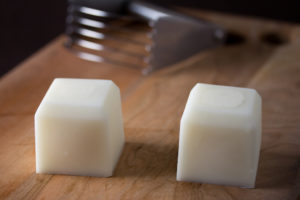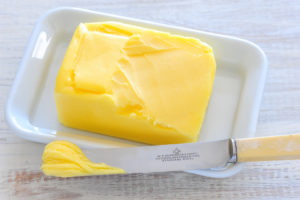What is Shortening?
While technically shortening is any fat that is solid at room temperature, “shortening” typically refers specifically to hydrogenated vegetable oils. Shortening gets its name from the effect it has on gluten production; the fats shorten gluten strands, making baked goods tender and flaky.
How Shortening is Made
Vegetable shortening is made via a hydrogenation process. An extra hydrogen atom is added to vegetable oils which creates a solid fat.
Why Shortening is Great for Baking
Because shortening is 100% fat (butter is only 80% fat) it typically produces the most tender and crumbly results. Shortening can be melted or softened and creamed into a dough or batter (think cake or cookies). It can also be kept solid and cut into mixtures like pie crust for flaky results. It has a higher melting point than butter and doesn’t require refrigeration; this is great news for cake decorators who want frosting to hold up in warmer temperatures.
Shortening Substitutes
Vegetable shortening can be replaced by just about any other solid fat. Each option, however, will slightly affect the taste and texture of baked goods. Butter adds delicious flavor to pastries and other baked goods. However, if mixtures become too warm the water in butter can toughen the gluten in your batter or dough. Lard is another great substitution option but may add unwanted flavor.
Shortening and Temperature
When baking pastries, it’s typically best to keep shortening at room temperature (68-72°F). For home bakers, this often means finding ways to keep shortening cool; ovens can heat up a kitchen significantly during the baking process. For commercial bakers who use large, unheated storage rooms or who need to soften large amounts of shortening, a heating option might be required.
Powerblanket Hot Boxes
Powerblanket Hot Boxes can be a great addition to your commercial baking equipment. Whether you need to keep shortening from getting too cold in storage or soften a large quantity, hot boxes allow you to uniformly heat your bulk materials. They are installed quickly and effortlessly and are easy to remove and store. Call us today at 888.316.6324 for more info.
Frequently Asked Questions
What is shortening in baking substitute?
Margarine and butter can both be used as substitutes for shortening, but their moisture content should be considered, as shortening is 100% fat and adds more richness and tenderness to baked goods.
Is Crisco the same as shortening?
Crisco is a well-known brand of shortening, which is a type of solid fat used in baking to create tender, flaky textures in products like cookies, pie crusts, and cakes.
Can I just use butter instead of shortening?
Yes, butter can be used instead of shortening in a one-to-one swap, but the results may vary due to differences in fat content and moisture, which can affect the texture and flavor of the baked goods.
What is an example of a shortening in baking?
An example of shortening in baking is hydrogenated vegetable oil, which is commonly used to prevent gluten formation and achieve a tender, crumbly texture in baked goods.
The Powerblanket Hot Box is the perfect solution for your bulk material heating needs.





